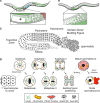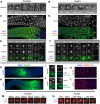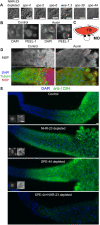The conserved molting/circadian rhythm regulator NHR-23/NR1F1 serves as an essential co-regulator of C. elegans spermatogenesis
- PMID: 33060131
- PMCID: PMC7710015
- DOI: 10.1242/dev.193862
The conserved molting/circadian rhythm regulator NHR-23/NR1F1 serves as an essential co-regulator of C. elegans spermatogenesis
Abstract
In sexually reproducing metazoans, spermatogenesis is the process by which uncommitted germ cells give rise to haploid sperm. Work in model systems has revealed mechanisms controlling commitment to the sperm fate, but how this fate is subsequently executed remains less clear. While studying the well-established role of the conserved nuclear hormone receptor transcription factor, NHR-23/NR1F1, in regulating C. elegans molting, we discovered that NHR-23/NR1F1 is also constitutively expressed in developing primary spermatocytes and is a critical regulator of spermatogenesis. In this novel role, NHR-23/NR1F1 functions downstream of the canonical sex-determination pathway. Degron-mediated depletion of NHR-23/NR1F1 within hermaphrodite or male germlines causes sterility due to an absence of functional sperm, as depleted animals produce arrested primary spermatocytes rather than haploid sperm. These spermatocytes arrest in prometaphase I and fail to either progress to anaphase or attempt spermatid-residual body partitioning. They make sperm-specific membranous organelles but fail to assemble their major sperm protein into fibrous bodies. NHR-23/NR1F1 appears to function independently of the known SPE-44 gene regulatory network, revealing the existence of an NHR-23/NR1F1-mediated module that regulates the spermatogenesis program.
Keywords: Auxin-inducible degron; C. elegans; Meiosis; NHR-23; Nuclear hormone receptor; Spermatogenesis.
© 2020. Published by The Company of Biologists Ltd.
Conflict of interest statement
Competing interestsThe authors declare no competing or financial interests.
Figures








Similar articles
-
NHR-23 and SPE-44 regulate distinct sets of genes during Caenorhabditis elegans spermatogenesis.G3 (Bethesda). 2022 Nov 4;12(11):jkac256. doi: 10.1093/g3journal/jkac256. G3 (Bethesda). 2022. PMID: 36135804 Free PMC article.
-
The intrinsically disordered protein SPE-18 promotes localized assembly of MSP in Caenorhabditis elegans spermatocytes.Development. 2021 Mar 5;148(5):dev195875. doi: 10.1242/dev.195875. Development. 2021. PMID: 33558389 Free PMC article.
-
NHR-23 activity is necessary for C. elegans developmental progression and apical extracellular matrix structure and function.Development. 2023 May 15;150(10):dev201085. doi: 10.1242/dev.201085. Epub 2023 May 22. Development. 2023. PMID: 37129010 Free PMC article.
-
Spermatogenesis-defective (spe) mutants of the nematode Caenorhabditis elegans provide clues to solve the puzzle of male germline functions during reproduction.Dev Dyn. 2010 May;239(5):1502-14. doi: 10.1002/dvdy.22271. Dev Dyn. 2010. PMID: 20419782 Free PMC article. Review.
-
Spermatogenesis in mammals: proteomic insights.Syst Biol Reprod Med. 2012 Aug;58(4):179-90. doi: 10.3109/19396368.2012.691943. Syst Biol Reprod Med. 2012. PMID: 22788530 Review.
Cited by
-
Ror homolog nhr-23 is essential for both developmental clock and circadian clock in C. elegans.Commun Biol. 2024 Feb 28;7(1):243. doi: 10.1038/s42003-024-05894-3. Commun Biol. 2024. PMID: 38418700 Free PMC article.
-
NHR-23 and SPE-44 regulate distinct sets of genes during Caenorhabditis elegans spermatogenesis.G3 (Bethesda). 2022 Nov 4;12(11):jkac256. doi: 10.1093/g3journal/jkac256. G3 (Bethesda). 2022. PMID: 36135804 Free PMC article.
-
Efficient generation of a single-copy eft-3p::TIR1::F2A:: BFP::AID*::NLS allele in the C. elegans ttTi5605 insertion site through recombination-mediated cassette exchange.MicroPubl Biol. 2021 Aug 3;2021:10.17912/micropub.biology.000425. doi: 10.17912/micropub.biology.000425. eCollection 2021. MicroPubl Biol. 2021. PMID: 34355140 Free PMC article.
-
Loss of the Na+/K+ cation pump CATP-1 suppresses nekl-associated molting defects.G3 (Bethesda). 2024 Oct 21;14(12):jkae244. doi: 10.1093/g3journal/jkae244. Online ahead of print. G3 (Bethesda). 2024. PMID: 39428996 Free PMC article.
-
Clock gene homologs lin-42 and kin-20 regulate circadian rhythms in C. elegans.Sci Rep. 2024 Jun 5;14(1):12936. doi: 10.1038/s41598-024-62303-9. Sci Rep. 2024. PMID: 38839826 Free PMC article.
References
-
- Alvarez J. D., Hansen A., Ord T., Bebas P., Chappell P. E., Giebultowicz J. M., Williams C., Moss S. and Sehgal A. (2008). The circadian clock protein BMAL1 is necessary for fertility and proper testosterone production in mice. J. Biol. Rhythms 23, 26-36. 10.1177/0748730407311254 - DOI - PMC - PubMed
-
- André E., Conquet F., Steinmayr M., Stratton S. C., Porciatti V. and Becker-André M. (1998). Disruption of retinoid-related orphan receptor β changes circadian behavior, causes retinal degeneration and leads to vacillans phenotype in mice. EMBO J. 17, 3867-3877. 10.1093/emboj/17.14.3867 - DOI - PMC - PubMed
-
- Ashley G., Duong T., Levenson M. T., Martinez M. A. Q., Hibshman J. D., Saeger H. N., Doonan R., Palmisano N. J., Martinez-Mendez R., Davidson B. et al. (2020). Expanding the Caenorhabditis elegans auxin-inducible degron system toolkit with internal expression and degradation controls and improved modular constructs for CRISPR/Cas9-mediated genome editing. bioRxiv. 10.1101/2020.05.12.090217 - DOI

